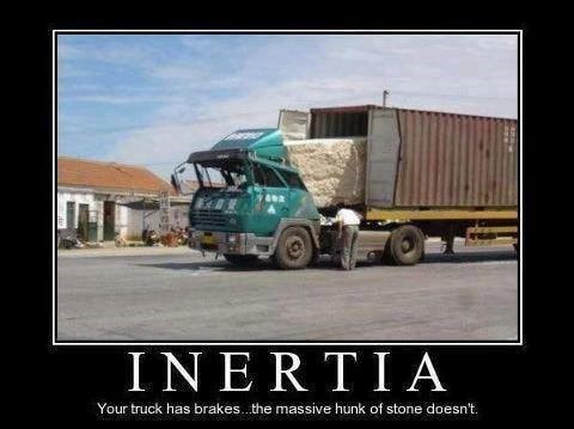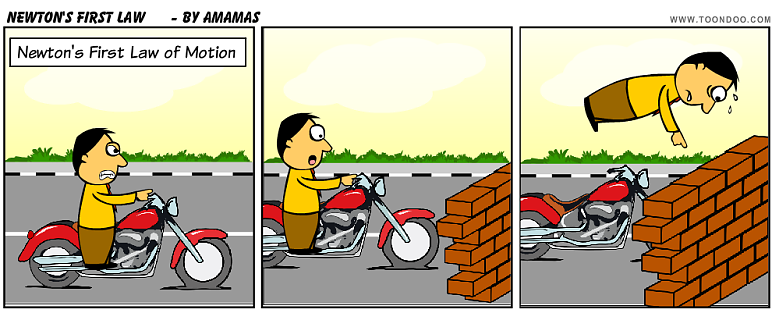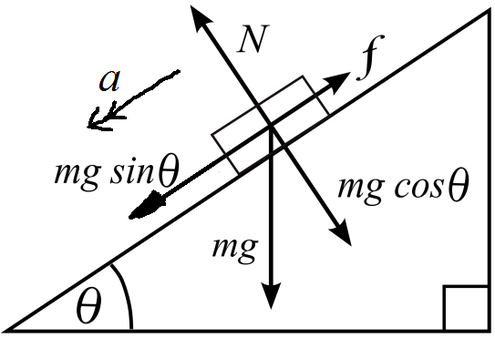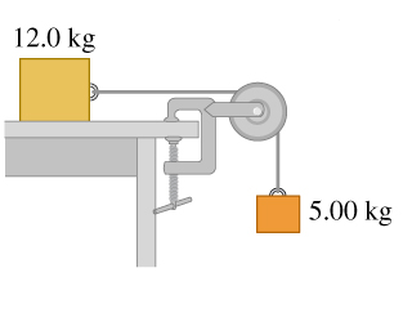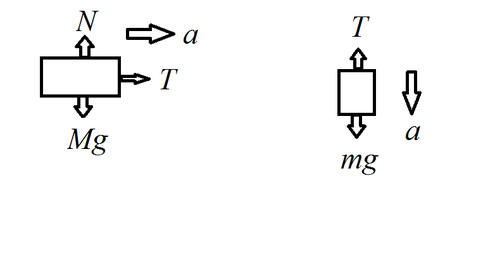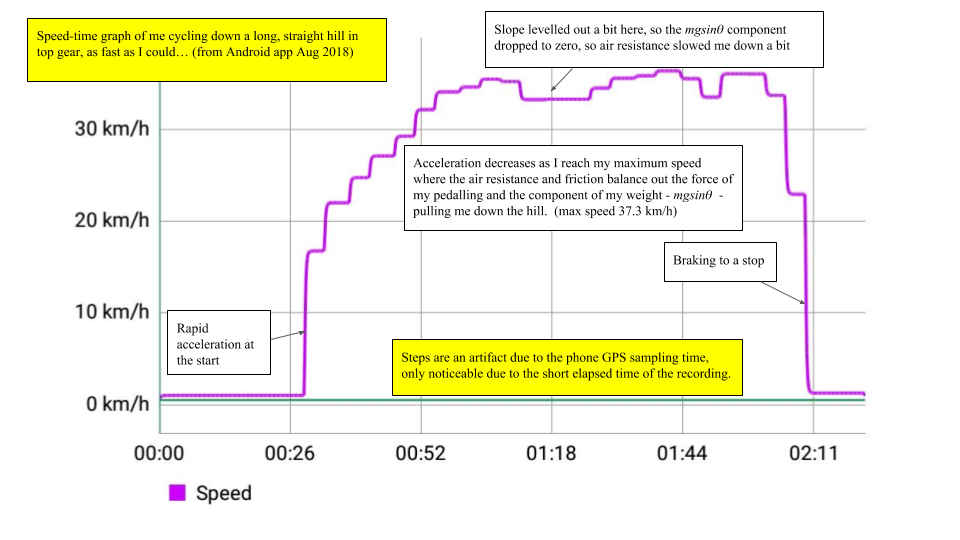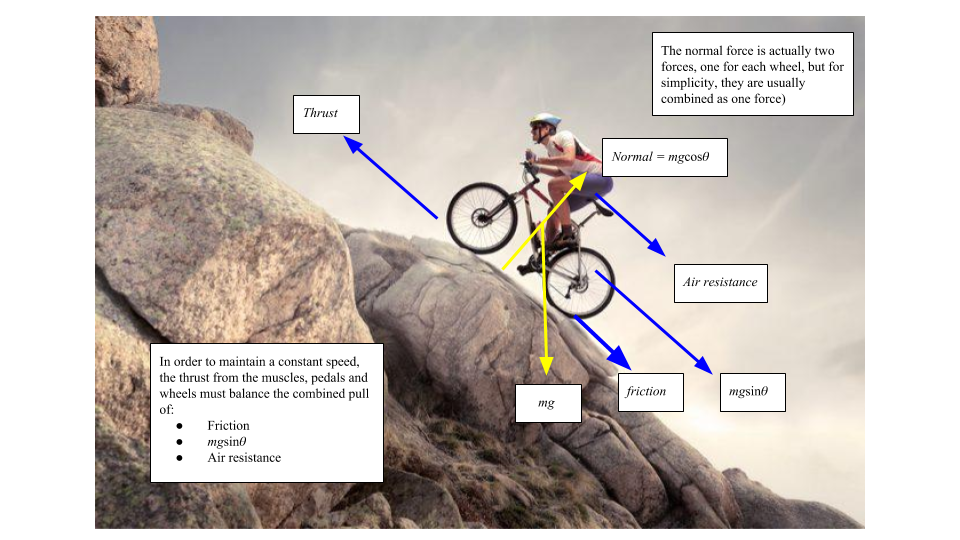|
Friction >>
|
2.3 - Newton's Laws
Objectives:
- To understand the basics of the three laws of motion.
- To be able to use these laws in a variety of contexts
- To be able to solve dynamics problems.
Two examples of Newton's First Law in action. Mass has a tendency to resist a CHANGE in motion. This tendency is called INERTIA. Inertia can be considered identical to mass at this point. (Things change as we progress further in physics to the realms of quantum mechanics and relativity.) In the above cartoon, the rider can feel as if he has been THROWN off in a forwards direction from the bike. But this is false as there is no force propelling him (no magic springs under the seat ?)... Instead, looking from outside the situation it is clear that the bike stops underneath him and he has continued to move at a constant velocity forwards. He should wearing a HELMET by the way.
Dynamics is the study of CHANGES in motion. These changes are caused by an unbalanced force acting on the object(s). Newton realised that the change in the motion (ACCELERATION) depended on a) the size and direction of the unbalanced force and b) the natural resistance to change of the object, i.e. its inertial mass. This is formalised by Newton's Second Law of Motion. So if the condition for an UNBALANCED force is: \[\sum F\neq 0\]
Dynamics is the study of CHANGES in motion. These changes are caused by an unbalanced force acting on the object(s). Newton realised that the change in the motion (ACCELERATION) depended on a) the size and direction of the unbalanced force and b) the natural resistance to change of the object, i.e. its inertial mass. This is formalised by Newton's Second Law of Motion. So if the condition for an UNBALANCED force is: \[\sum F\neq 0\]
As the unbalanced force increases, the acceleration increases in proportion. (a 100 cc bike accelerates faster than a 50 cc one).
As the mass of the object increases, the acceleration decreases in proportion. (a heavier bike accelerates slower than a lighter one) \[a = \frac{\sum F}{m}\]
Which is usually simplified slightly and remembered as: \[F=ma\]
Now, this seems a ridiculously easy equation to use! Well it is... So why are the homework and test problems always so hard to solve? The hard part is usually in determining the \(F\) part. Sometimes even the mass is not as straightforward as it would appear. Free-body diagrams are incredibly useful to sort out which forces are affecting which masses in which direction! At AP level what you will never see is an IGCSE style question where you just need to plug in the numbers.
As the mass of the object increases, the acceleration decreases in proportion. (a heavier bike accelerates slower than a lighter one) \[a = \frac{\sum F}{m}\]
Which is usually simplified slightly and remembered as: \[F=ma\]
Now, this seems a ridiculously easy equation to use! Well it is... So why are the homework and test problems always so hard to solve? The hard part is usually in determining the \(F\) part. Sometimes even the mass is not as straightforward as it would appear. Free-body diagrams are incredibly useful to sort out which forces are affecting which masses in which direction! At AP level what you will never see is an IGCSE style question where you just need to plug in the numbers.
Example 3
A student rolls down Knapton Hill on a bicycle. Their total mass is \(100 \,\text{kg}\) and the angle of the slope is \(5^{\circ}\). Friction has been measured to be \(50 \,\text{N}\). What is a) his acceleration and b) his final speed at the bottom of the \(500 \,\text{m}\) long hill?
Using a similar diagram as before, but notice that the component of weight down the slope is greater than the friction and that an acceleration vector is clearly shown:
A student rolls down Knapton Hill on a bicycle. Their total mass is \(100 \,\text{kg}\) and the angle of the slope is \(5^{\circ}\). Friction has been measured to be \(50 \,\text{N}\). What is a) his acceleration and b) his final speed at the bottom of the \(500 \,\text{m}\) long hill?
Using a similar diagram as before, but notice that the component of weight down the slope is greater than the friction and that an acceleration vector is clearly shown:
|
a) The overall unbalanced force is: \[F = mg\sin \theta -f\]
Newton's second law: \[F=ma\]
Substituting in the unbalanced force for F gives us: \[mg\sin \theta -f=ma\]
Substituting the data gives us: \[a = 9.81\sin 5-0.5=0.35\text{m/s}^{2}\]
b) Using the kinematics equation: \[v^{2}=v_{o}^{2}+2ax\]
and substituting the given data we get: \[v^{2}=0+2\times 0.35\times 500\] \[v=18.7\text{m/s}\]
|
Example 4
Two blocks are connected by a string. No friction.
Two blocks are connected by a string. No friction.
Method 1 - individual block approach using separate free-body diagrams. (note that the masses are different and denoted by a different case, although it is also common to use subscripts)
\(5 \,\text{kg}\) block: Note that \(mg > T\) as it accelerates downwards: \[F=ma\] \[mg-T=ma\]
\(12 \,\text{kg}\) block: \[F=Ma\] \[T=Ma\]
Combining the simultaneous equations gives us: \[mg-Ma=ma\] \[a = \frac{mg}{(M+m)}=2.9\,\text{m/s}^2\]
\(12 \,\text{kg}\) block: \[F=Ma\] \[T=Ma\]
Combining the simultaneous equations gives us: \[mg-Ma=ma\] \[a = \frac{mg}{(M+m)}=2.9\,\text{m/s}^2\]
Method 2 - whole system approach. Treat both masses as one unit. Works and is quicker - but be careful with the forces and the masses. \[F=ma\]
The resultant force is \(mg\) and the overall mass that is being accelerated is \((m+M)\), so we have:
\[mg=(M+m)a\]
\[a=\frac{mg}{(M+m)}=2.9\,\text{m/s}^2\]
The resultant force is \(mg\) and the overall mass that is being accelerated is \((m+M)\), so we have:
\[mg=(M+m)a\]
\[a=\frac{mg}{(M+m)}=2.9\,\text{m/s}^2\]
Physics and Cycling
Below is a speed-time graph that I captured via a screenshot during a cycle ride over the summer break. To produce this graph I used a GPS mapping app on my phone (ViewRanger) and stopped at the top of a reasonably long, straight and gentle inclined hill. No traffic as in the middle-of-nowhere Maine. What I was trying to show was that I would reach a maximum speed due to air resistance (similar in concept to Terminal Velocity). If the hill had been steeper and I had a more aerodynamic bike/outfit I could have gone faster. The air resistance increases as a function of the speed - roughly as a quadratic. Small increases in speed lead to large increases in air resistance. It is also a function of the cross-sectional area of the cyclist. The total distance travelled can be determined from the area under the graph and equals \(896 \,\text{m}\).
Below is a speed-time graph that I captured via a screenshot during a cycle ride over the summer break. To produce this graph I used a GPS mapping app on my phone (ViewRanger) and stopped at the top of a reasonably long, straight and gentle inclined hill. No traffic as in the middle-of-nowhere Maine. What I was trying to show was that I would reach a maximum speed due to air resistance (similar in concept to Terminal Velocity). If the hill had been steeper and I had a more aerodynamic bike/outfit I could have gone faster. The air resistance increases as a function of the speed - roughly as a quadratic. Small increases in speed lead to large increases in air resistance. It is also a function of the cross-sectional area of the cyclist. The total distance travelled can be determined from the area under the graph and equals \(896 \,\text{m}\).
I could not persuade Kate to come out and take a photo of me cycling uphill, nor could I find a suitable photo of Flora Duffy climbing corkscrew hill during the World Triathlon event, so I have used a stock photo from Google Images - looks kind of mad, but anyhoo...
|
|
Apollo 8 launch. This is another famous example of Newton's second law. To reach the Moon, the rocket must accelerate to a very high velocity, but that requires a lot of fuel. Fuel adds mass, therefore the engines must be even more powerful, which burns more fuel, which means a heavier rocker, which means larger engines and so on. The thrust was generated by burning \(20 \,\text{tons}\) of fuel per second from the first stage engines. Another limit of the rocket was that the humans can only withstand a certain acceleration, approx \(4.5g\). The Saturn V moonrockets are still the most powerful machines ever built.
Popular Mechanics article NASA InfoGraphic |
Friction >>
Other Resources
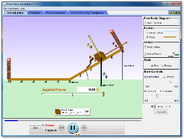
Newton's Laws and Car Crashes - recommended by Morgan Kornarski of Safe Kids
|
